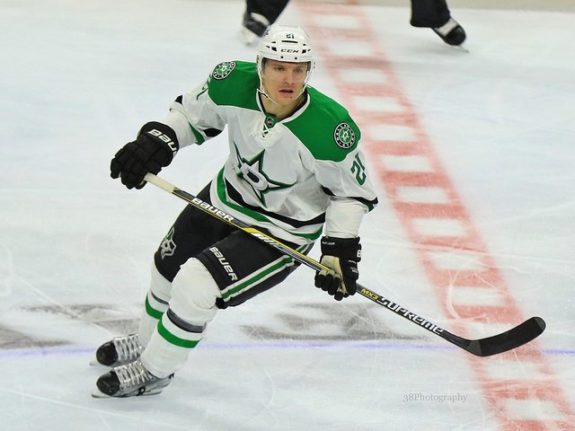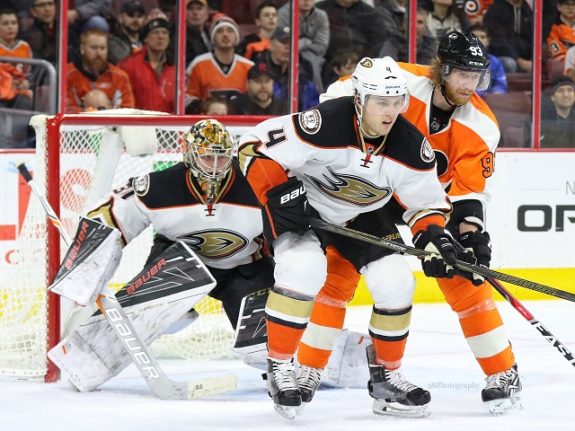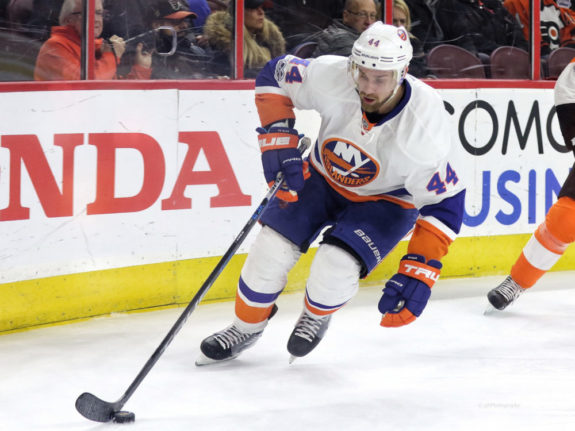What can the Dallas Stars get for Cody Eakin?
That question must be on General Manager Jim Nill’s mind as June 17 approaches. On that date, he’ll submit a list of protected Stars to the Vegas Golden Knights for their expansion draft. For Eakin to be protected, the Stars would likely have to expose feisty winger and fan favorite Antoine Roussel, a possibility which holds little appeal for organization and fan base alike.

Eakin, on the other hand, has been a versatile and valuable part of the team since he was acquired from the Washington Capitals for Mike Ribeiro in 2012. Throughout his five seasons in Dallas, the “Ginger Ninja” has played up and down the lineup, centering Jamie Benn and Tyler Seguin some nights, Roussel and Ales Hemsky others. Despite his struggles last season, which began with a training camp injury and mirrored that of the team as a whole, Eakin remains a solid option as a two-way, second- or third-line pivot…and therein lies the problem.
New Stars head coach Ken Hitchcock has stated his desire to move Seguin back to the middle. Jason Spezza, who skated most of last season on the unfamiliar and uncomfortable wing, is expected to follow suit. With Radek Faksa seemingly locked in as third line center, Eakin is the odd-man out.
Should the Stars decide to shop Eakin, his reasonable cap hit ($3.85 million for three more years), age (26 as of May 24) and experience (379 NHL games played over six seasons) will make him very attractive to many teams. With several clubs facing tough expansion draft-related decisions of their own, the Stars can, and should, leverage Eakin to fill their most pressing need.
What Do the Stars Need Now?
Nill largely remedied the Stars’ goaltender problem with the acquisition of Ben Bishop. Hitchcock’s goalie-friendly defensive scheme will plug the leaks which tormented the team last season, but one element is lacking: a top-four, left-handed defenseman in, or approaching, his prime.
The Stars are set down the right side of the blue line, with John Klingberg, Stephen Johns and Julius Honka expected to fill those spots next season. On the left, Esa Lindell and Dan Hamhuis are locks. With the club in “win-now” mode, Nill is unlikely to gamble on either Jamie Oleksiak or Patrik Nemeth seizing the final port-side position.
Of the 29 other clubs scheming to protect as many assets as possible from expansion draft exposure, four in particular could find a trade for Eakin mutually beneficial.
The Predators’ Predicament
The Nashville Predators have one of the deepest, most talented defense corps in the NHL. While their blueliners are playing a major role in the Preds’ postseason success, that combination of depth and talent could be a liability less than a month from now.
With four key defensemen in need of protection from the Golden Knights’ clutches, the Predators must trade one or shield just four forwards, instead of seven. In that scenario, center Calle Jarnkrok would likely be one of the exposed forwards, and his team-friendly contract (five years remaining at $2 million per year) makes him an attractive target for the Golden Knights. And as recent injuries to Ryan Johansen and team captain Mike Fisher have shown, the Preds can’t afford to get thinner down the middle of the ice.
Two Music City blueliners meet the Stars’ requirements: Roman Josi and Mattias Ekholm. The latter would be easiest to acquire, as the former has blossomed into one of the league’s elite defensemen. Given Nill’s willingness to trade the third-overall pick in next month’s draft, however, a package deal including Eakin, the pick and more for Josi can’t be ruled out.

The Ducks’ Dilemma
Like their Western Conference Final opponents, the Anaheim Ducks have four defensemen in dire need of protection. Unlike the Preds, the Ducks also have to deal with a fifth defender, Kevin Bieksa, who has a no-move clause in his contract and must be protected.
Even if Bieksa agrees to waive his NMC, shielding four defensemen means the West Coast Waterfowl can only protect one of Rickard Rakell, Jakob Silfverberg and Andrew Cogliano, among others. Given their depth along the blue line, a trade makes sense.
Given the opportunity, the Stars would target Hampus Lindholm or Cam Fowler. Of the pair, Fowler seems most likely to be moved, as he’ll be an unrestricted free agent next summer and will certainly seek a raise over his current $4 million annual salary.
Beyond expansion draft issues, the absence of a contract extension means Fowler’s trade value will only drop over time. Meanwhile, adding Eakin would bolster the Ducks’ center depth, as he represents an upgrade over the aging Antoine Vermette and pending-UFA Nate Thompson. Ironically, acquiring the Ducks’ defender would also right a wrong for the Stars: Anaheim selected Fowler with the 12th pick in the 2010 NHL Entry Draft, immediately after Dallas burned the 11th pick on goalie Jack Campbell.

The Islanders’ Issue
Simply put, the New York Islanders have an embarrassment of riches on the blue line. Unlike virtually every other club, the Isles have five defensemen they’d like to protect. While that’s allowed under the expansion draft rules, doing so would mean just three forwards would be unavailable to the Golden Knights, who would then have their choice of such quality forwards as Brock Nelson, Josh Bailey and Ryan Strome.
Moving two of their top-five defenders makes the most sense for the Islanders, who could parlay those players into some much-needed upgrades at center and wing while protecting at least two of Nelson, Bailey and Strome.
Defensemen Nick Leddy and Calvin de Haan should draw interest from the Stars. Leddy is top dog on the Isles’ blue line and led their defense corps in average time on ice (22:43), points (46) and power-play points (15) last season. Just 26 years old, Leddy is under contract for five more years at $5.5 million per. While he’s not untouchable, the Islanders’ top defenseman could cost the Stars more than Eakin and their top draft pick.
de Haan, on the other hand, represents a relatively low-cost option. Though the same age as Leddy, de Haan is a restricted free agent who took home $2.9 million in actual salary against a cap hit of $1.967 million last season. Playing 19:50 a night in 2016-17, he finished ahead of Leddy in several key statistical categories, including scoring chances for- and against and goals for- and against per 60 minutes, all at even-strength. A straight Eakin-for-de Haan swap makes sense for both teams.
The Hurricanes’ Landfall
The Carolina Hurricanes have been lost at sea and out of the playoffs since 2009. Though the last few years haven’t been fruitful on the ice, GM Ron Francis has been working behind the scenes, maneuvering the ‘Canes into position to take full advantage of other clubs prior to the upcoming expansion draft.
Even after sending a 2017 third-round pick (previously acquired from Ottawa) to the Chicago Blackhawks for goalie Scott Darling, the Hurricanes have six picks in the first three rounds of this summer’s draft. With 16 players under contract for 2017-18, they still have over $27 million in cap space. As teams become desperate to move or (potentially) lose valuable assets prior to June 17, Francis is prepared to take advantage.
While the Stars aren’t desperate, they have in Eakin a commodity the ‘Canes could definitely use. In return, either Jaccob Slavin or Noah Hanifin would provide an instant upgrade to the Stars’ blue line.
Just 23 and 20 years old, respectively, Slavin and Hanifin each have two NHL seasons under their belts. 2016-17 was a breakout season for the former, who finished second in points among Hurricanes defensemen while leading that group in ice time. Hanifin, meanwhile, came in third in points while playing just under 18 minutes a night.
Worth noting, both ‘Canes blueliners are exempt from the expansion draft. Thus, a trade for either player would still allow the Stars to protect John Klingberg, Esa Lindell and either Stephen Johns or Jamie Oleksiak. That, combined with their low cap hits (both come in under $1 million for 2017-18) and cost-saving status as restricted free agents next summer, makes both Slavin and Hanifin attractive trade targets for the Stars.